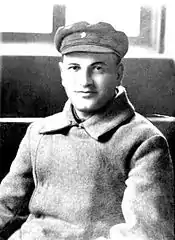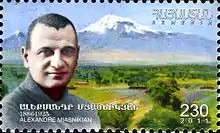Alexander Miasnikian
Alexander Fyodori Miasnikian, Myasnikyan[1] or Myasnikov (Armenian: Ալեքսանդր Ֆեոդորի (Աստվածատուրի) Մյասնիկյան; Russian: Алекса́ндр Фёдорович Мяснико́в; Aleksandr Fyodorovich Myasnikov; 28 January [9 February] 1886 – 22 March 1925) was an Armenian Bolshevik revolutionary and official. Miasnikian's revolutionary nom de guerre was Martuni.
Alexander Miasnikian | |
|---|---|
 | |
| Chairman of the Council of People's Commissars of Armenia | |
| In office 1 January 1921 – 30 January 1922 | |
| Preceded by | Sarkis Kasyan (as Chairman of the Military Revolutionary Committee) |
| Succeeded by | Sargis Lukashin |
| First Secretary of the Communist Party of Belarus | |
| In office 1918–1919 | |
| Personal details | |
| Born | 9 February 1886 Nor Nakhichevan, Don Voisko Oblast, Russian Empire |
| Died | 22 March 1925 (aged 39) near Tiflis, Georgian SSR, Soviet Union |
| Nationality | Armenian |
| Political party | RSDLP (Bolsheviks) (1904–1918) Russian Communist Party (1918–1925) |


Biography
Miasnikian was born in the Armenian-populated city of New Nakhichevan (now a part of Rostov-on-Don) to the family of a merchant. He graduated from the law department of Moscow University in 1911. As a student in New Nakhichevan and later in Moscow, Miasnikian was active in underground groups beginning from 1901 and formally became a member of the revolutionary movement in 1904. He was arrested and exiled to Baku in 1906.[2]
Between 1912 and 1914, Miasnikian worked as an assistant to a lawyer in Moscow and participated in disseminating political literature. He was drafted into the Russian Army in 1914, where he promoted revolutionary ideas among the soldiers.
After the February Revolution of 1917, Miasnikian became a member of the Western Front's frontline committee and was an editor of the Bolshevik newspaper Zvezda in Minsk. He was elected as a delegate for the 6th Congress of the Bolshevik Party. He became chairman of the Northwestern Regional Committee of the Bolshevik Party, and became part of the Military Revolutionary Committee of the Western Region. Miasnikian was elected the commander of the Western Front at the congress of deputies.
Despite being an active opponent of the idea of a Belarusian autonomy,[3] in 1918, he was appointed the first chairman of the Communist Party of Byelorussia. From 4–27 February 1919, Miasnikian was chairman of the Central Executive Committee of the Socialist Soviet Republic of Byelorussia that briefly existed in January and February of that year. He was a member of the Central Committee of the Bolshevik Party for the short-lived Lithuanian–Belorussian Soviet Socialist Republic.
When Nikolai Krylenko was appointed Supreme Commander in Chief of the Red Army, he in turn appointed Miasnikian as his deputy.[4]
In 1921, after the February Uprising where forces of the Armenian Revolutionary Federation briefly overthrew Soviet authority in Armenia, Miasnikian was appointed Chairman of the Council of People's Commissars of Armenia, the newly installed government of the Armenian Soviet Socialist Republic. On his way to Armenia, he delivered Lenin's letter "To the Comrade Communists of Azerbaijan, Georgia, Armenia, Dagestan, and the Mountainous Republic" to the Caucasian Bolshevik leadership in Tiflis, which called on them to exercise moderation and slow down their transition to socialism.[5]
After being appointed as a head of government during the early years of the Armenian Soviet Republic, Miasnikian was faced with two urgent issues: the anti-Bolshevik rebellion in the southern region of Zangezur and the question of Mountainous Karabakh, an Armenian-populated region disputed between Soviet Armenia and Soviet Azerbaijan.[5] Miasnikian engaged in negotiations with the rebels in Zangezur, offering a number of concessions in return for accepting Soviet authority in Armenia, but on June 3, 1921 the Kavbiuro (the Bolshevik Party's decision-making body in the Caucasus) resolved to suppress the rebellion. The rebels were defeated and fled into Persia in July.[5]
The resolution adopted at the Kavbiuro meeting on June 3 (at which Miasnikian was present) included a point which stated that Mountainous Karabakh should be declared a part of Armenia. On June 12, Miasnikian signed a decree adopted by the Soviet Armenian government which stated that the Revkoms of Armenia and Azerbaijan had agreed that Mountainous Karabakh was now an inalienable part of Armenia.[5] However, there was disagreement from the Azerbaijani side, which insisted on leaving the final resolution of the status of Karabakh for future Kavbiuro meetings. At a Kavbiuro meeting on July 4, 1921, Miasnikian and a majority of members voted to conduct a referendum in the Armenian-populated mountainous part of Karabakh and make it part of Armenia. Just the next day, Kavbiuro decided to revise the decision and adopt a new one whereby Mountainous Karabakh would become an autonomous region within the Azerbaijani SSR.[5] The Central Committee of the Armenian Communist Party unsuccessfully protested the decision. Six months later, Miasnikian told the First Congress of the Armenian Communist Party that Azerbaijan had threatened to cut off Armenia's supply of kerosene if they demanded Karabakh.[6]
Miasnikian was instrumental in the formation of state institutions and economy of the republic. Miasnikian also initiated active work towards eradicating the illiteracy and developing local manufacturing in Armenia.
Miasnikian wrote several works about the theory of Marxism-Leninism, the history of the revolutionary movement, and Armenian literature. He began writing reviews for theater in 1906. His works about Armenian literature include the article "Mikael Nalbandian" and pamphlets on the poetry of Hovhannes Hovhannisyan and Hovhannes Tumanyan. In literature, Miasnikian criticized apolitical approaches to literature and the concept of "art for art's sake" in articles like "Philanthropy and its Lackeys" (1912).[2]
Death
Miasnikian was killed in a mysterious plane crash on 22 March 1925, along with Solomon Mogilevsky, Georgi Atarbekov, the pilot and flight engineer. They had been on their way to Sukhumi for an Abkhazia communist conference. Shortly after taking off from Tiflis, the Junkers F.13 aircraft caught fire. According to eyewitness reports, people were seen jumping to their deaths to escape the burning plane.[7]
The cause of the fire was never established, despite separate investigatory commissions chaired by Lavrenty Beria (first) and Karl Pauker (second and third). Nothing was found to be wrong with the plane mechanically.[7] Leon Trotsky, who left Sukhumi for the funeral in Tiflis, was suspicious of the cause of the crash.[8] Others who believed it was deliberate suspected Beria himself had organized it.[1]
Legacy
Miasnikian is one of the few communist leaders still celebrated in Armenia after the dissolution of the Soviet Union. A monument is situated in the center of Yerevan commemorating him.
Several locations within the Soviet Union were named after him (including "Martuni", his nom de guerre): In Armenia, a city and two villages (in Gegharkunik and Armavir provinces). In Russia's Rostov Oblast, an Armenian-populated raion (district) is called after him. In the disputed Nagorno-Karabakh Republic, a city and a province are called Martuni.
References
- "Former Prime Ministers". Government of Armenia. Retrieved 8 July 2015.
- Miasnikov, Aleksandr Federovich. Great Soviet Encyclopedia
- Калубовіч, Аўген (1985). ""Айцы" БССР і іхны лёс [The "fathers" of the BSSR and their fate]" (in Belarusian). Cleveland. Retrieved 2 January 2018.
- From Tsarist General to Red Army Commander by Mikhail Bonch-Bruyevich, translated by Vladimir Vezey, Progress Publishers, 1966, p. 232
- Saparov, Arsène (March 2012). "Why Autonomy? The Making of Nagorno-Karabakh Autonomous Region 1918-1925". Europe-Asia Studies. 64 (no.2): 281–323. Retrieved 30 December 2020.
- Suny, Ronald Grigor (1989). "Nationalism and Democracy in Gorbachev's Soviet Union: The Case of Karabagh". Michigan Quarterly Review. XXVIII (4): 481–506. hdl:2027/spo.act2080.0028.004:03.
- Yevgeny Zhirnov (8 September 2008). "Нелепая и чудовищная катастрофа" ["Absurd and Monstrous Catastrophes"]. Kommersant (in Russian). Retrieved 14 February 2015.
- Stephen Kotkin (2014). Stalin: Volume I: Paradoxes of Power, 1878-1928 (ePub ed.). Penguin Press. pp. 2615–2616. ISBN 978-1594203794.
Further reading
| Wikimedia Commons has media related to Alexander Myasnikyan. |